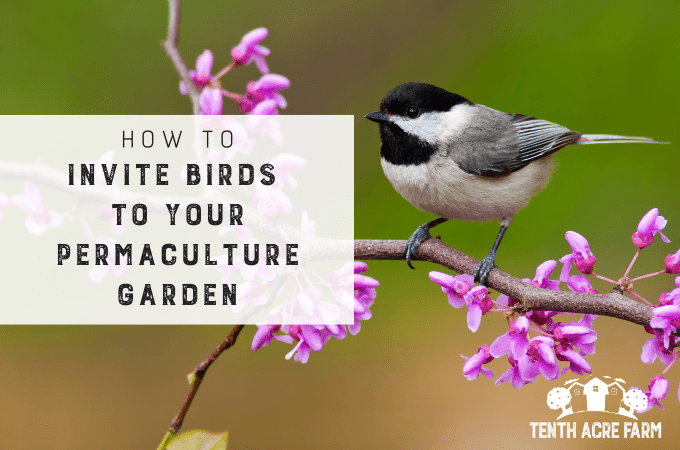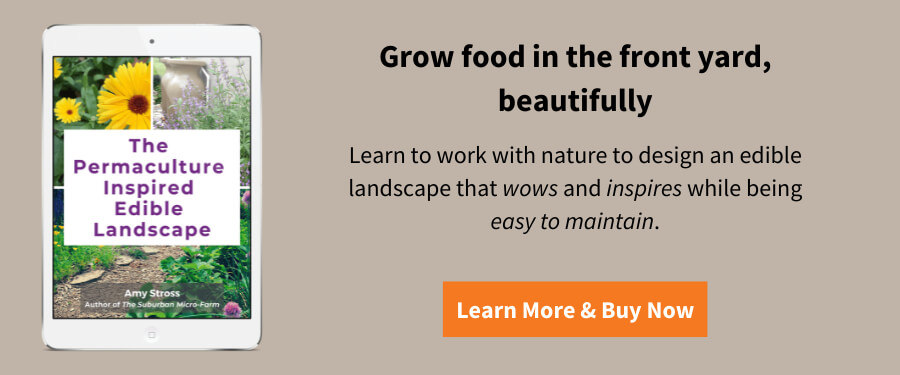Would you like to welcome birds to your permaculture garden while still getting a harvest? Learn the benefits of making your food garden a bird-friendly haven, and how to do it.

This page may contain affiliate links. Please read my disclosure for more info.
Songbirds may be essential components of a healthy ecosystem, but they aren’t always welcome in the backyard food garden. That’s because—if you haven’t planned accordingly—they can decimate a berry crop, peck holes in fruit, scratch up young seedlings, and perform other bothersome acts.
So why the heck should you welcome them into your food garden?
(Above image: A chickadee perches in an eastern redbud tree.)
Birds in the Permaculture Garden
In the permaculture garden, for starters, the goal is to partner with nature and integrate ourselves into the local environment. We find solutions that allow both humans and wildlife to meet their needs.
Obtaining a yield for humans at the expense of wildlife only creates more problems.
As Toby Hemenway, author of Gaia’s Garden: A Guide to Small-Scale Permaculture puts it, “by attracting birds, small animals, and insects to our yards, we not only increase biodiversity but make our gardens more balanced, disease free, and productive as well.”
Likewise, in the permaculture-designed yard, we don’t nurture habitat solely for birds (or other wildlife), at the expense of growing some of our own food. The resulting wildlife garden would be wonderfully peaceful, but it would require humans to outsource their own food.
Generations of prioritizing food for wildlife over food for humans in our yards has resulted, in part, in the current globalized food system that values neither the humans involved in its production nor the ecosystem.
Deforestation, soil erosion, and poorly treated farm workers are just a few of the results of a society that does not take responsibility for its own existence. The current food system also doesn’t account for the vulnerability of relying on far-away sources for our own sustenance.

A cedar waxwing eats an eastern red cedar (juniper) berry.
So, we work to find the balance and benefits of a human-wildlife partnership. We turn problems into solutions.
You might be wondering, “Can I really welcome songbirds into my garden and still get a harvest?” and the answer is, “Absolutely!”
First, let’s take a look at exactly how birds can be beneficial to food gardens and the gardeners who tend them. Next, we’ll look at just how to create the bird habitat to pull this off.
Tired of generic permaculture design advice that you can’t apply to your specific goals? If so, check out my Permaculture Design Program and get the tools and support needed to create and implement your own permaculture design.
Benefits of the Bird-Friendly Food Garden
From an enjoyment point of view, our feathered friends provide beauty, comic relief, and entertainment as they go about their daily lives.
They sing for their supper while providing insight into animal behavior. We get to watch as they search for mates, build nests, mark their territory, raise young, socialize, and hunt and forage for food.
Learning bird language is a rewarding pastime and compliments the benefits of spending time in the garden. This 30-minute podcast episode about the American robin from my friends, The Nature Guys, is a great start to learning bird language.
More benefits: Birds keep insect problems in check while gifting fertilizer. They loosen soil while they forage and scratch.
Fortunately, you don’t have to give up your entire landscape to birds (or allow them to destroy your crops) in order to have a bird-friendly garden!
The Secret to Drawing Birds into the Food Garden (While Still Getting a Yield for Yourself)
Birds can be powerful allies in the garden and for connecting you to the world around you. However, they can wreak havoc if you haven’t planned accordingly. Problems often arise when good bird habitat is lacking and the birds are reduced to making due with what’s available.
I’ve received a lot of messages over the years from frustrated gardeners who have lost a berry harvest to birds. “What can I do?” they wonder.
My ‘Berries vs. Birds’ Edible Landscape Story
In truth, when I planted my edible front yard with currant bushes, black raspberries, strawberries, and cherry trees, I assumed the local songbirds would destroy any chance of a harvest.
So I purchased bird netting. My plan was to net 2/3 of my fruiting trees and bushes, while leaving 1/3 of them un-netted for the birds. (Sharing is caring, right?) However, when the first harvest season came around, I got busy and didn’t net them in time.
I anxiously held my breath and hoped the birds would be kind. I recalled tales from local farmers of decimated crops.
But you know what happened in my front yard? Complete coexistence. The birds ate a tiny, almost unnoticeable portion of the harvest, while I pulled in hundreds of pounds of unblemished fruit from my tiny yard.
My neighborhood was teeming with songbirds, so why was my garden spared from destruction?
True, my cat was occasionally outdoors as an old, lazy deterrent.
But the real reason came down to my yard’s bird-friendly habitat. It was quite accidental on my part, I assure you. But once I figured out why it was successful, I was able to replicate it elsewhere.
The Triple Combo that Makes the Human-Bird Coexistence Work
Kris Bordessa, author of Attainable Sustainable: The Lost Art of Self-Reliant Living (National Geographic, 2020), gives us some clues:
Creating a garden that your winged friends want to call home is easy. You’ll need to provide food, water, and shelter. Any of these elements will bring birds to your garden for a visit. But providing all three will make them more inclined to take up residence.”
(By the way, this beautiful book is full of ideas to inspire you as you create an ecologically friendly garden and a sustainable lifestyle. Worth a look!) 🙂
The secret to drawing birds into your garden, then, for all the benefits (and none of the negatives), is to provide the triple combo of food, water, and shelter. Havoc occurs when one of these is missing.
Let’s look at each of these categories, as well as how I was able to harvest so much fruit amidst a healthy bird population.
The Three Categories of Bird Habitat
As we look at ways to provide food, water, and shelter, again Kris has some good advice for us:
Variety is the spice of life, they say—but it’s also the key to creating a desirable bird habitat. Give them plenty of options, so whether they’re shopping for a new nesting spot or place to eat, they’ll have lots to choose from. Not all birds eat the same thing, and their nesting habits vary.”
In short, diversity of plantings is key in terms of plant types, textures, heights, and seasons of value.
For example, it’s important to think about year-round provisions for your bird friends. A fruiting tree is super-useful for birds while fruiting. But you’ll need to fill the other seasons with food sources, as well.

A Baltimore oriole takes off from a wild bramble cane.
1: Food
Songbirds, in general, have a varied diet of fruit/berries, insects, and nuts/seeds. Some birds eat specific things, while others are generalists. In addition, some are ground foragers, while others hunt above ground.
When I looked around my edible yard, I realized that I had an abundance of bird-friendly food sources available. Many food sources we both liked to eat, but because of the variety of plantings, there was enough for all of us:
1.) Hawthorn and crabapple trees, among other jelly fruits, provided bird-sized berries, which they preferred over my larger, human-sized fruit crops. Black raspberries were their second favorites, and even though I only had three plants, I still got a human harvest.
2.) The lush organic garden, with a variety of plant types and sizes, created a haven for insects of all types, which the birds obligingly kept in balance.
3.) A big, old oak tree provided acorns and an old maple tree provided “helicopter” seeds. Flower, herb, and weed seeds were available, too.
Year-Round Food Sources
- Evergreen trees provide shelter and protection as well as seeds and sap for food. Try Douglas fir, eastern red cedar, fir, holly, pine, spruce.
- Flowers, tall grasses and herbs provide cover for ground feeders, seeds, nectar, and hosts for insects. Living mulch provides habitat for a number of ground-dwelling insects.
- Fruits—late spring through summer: blueberry, brambles like blackberry and raspberry, cherry, elderberry, mulberry*, serviceberry, wild plum. *Mulberry is a favorite of birds (a decoy crop!) and will help deter them from your more favored harvests.
- Fruits—fall: aronia berries, dogwood (try Cornelian cherry or Kousa dogwood for human-edible berries), and sea buckthorn and buffaloberry, which are both nitrogen fixers. During this time, birds need to build up fat reserves for migration or for surviving cold winters.
- Fruits—winter: crabapple, hardy kiwi, hawthorn, highbush cranberry, medlar, sumac. These fruits cling to branches over winter.
- Nectar-producing plants for hummingbirds: bee balm, lupine, and sage are useful for humans, too. Maple and black locust trees also provide nectar.
- Nuts: butternut, chestnut, hazelnut, hickory, piñon, walnut. These trees offer protection and good nesting sites, as well. Bugs feed, hide, and lay eggs in tree bark, while insect-eating bugs are attracted to the trunks. And guess what is attracted to all of these bugs?

A white-throated sparrow feeds on red sumac berries.
2: Water
Birds love natural, moving water, such as a meandering stream, or a pond with shallow edges. You can replicate this with a 2-inch-deep bird bath that includes a fountain. Place it near a shrub so they have an escape route and can check for safety from a perch.
It has been said that birds (and squirrels!) will eat a fruit crop (your tomatoes!) simply for the moisture content when there isn’t a water source nearby.
It may seem inconvenient to provide bird baths, ponds, or other little water sources for wildlife, but your garden will certainly benefit.
3: Shelter and Protection
Birds need shelter from the elements and protection from predators, and it’s essential that they have it alongside their sources of food and water.
Tall grasses, dense shrubs, tall tree canopies, and thorny plants all provide a safe haven from extreme temperatures, heavy snow, hot sun, rain, and winter winds, as well as predators.
Different birds nest at different heights, which is why a diversity of trees and shrubs is important.
In addition to the plants already listed above under food sources, here are some other plants that can provide nesting sites, shelter, and protection for birds:

An American robin perches in a winterberry shrub.
Putting it Together in a Hedgerow
A hedgerow is a perfect opportunity to provide bird habitat in your yard, as well as edible treats and privacy for you. From the safety of a perch in the hedgerow, birds can survey your yard and garden for tasty treats.
In fact, a hedgerow can be considered a linear nature preserve, as it can provide all the food and shelter that songbirds need.
Plant it with a variety of food sources for all seasons, and supplement your plantings with a bird bath and squirrel-proof bird feeder. Be sure to put them near a window so you can enjoy the entertainment!
Would you like to grow food in your front yard without sacrificing curb appeal? Check out my mini guide, The Permaculture Inspired Edible Landscape.
Bats
You may also consider attracting bats to your permaculture garden.
According to Kris, “[bats] are a great help in creating a productive food system. They can also control the insect population and contribute to pollinating plants.” Score!
Research how to add bird and bat houses in the correct places to accommodate those species that may not find the habitat they prefer in your hedgerow plantings. Here are some birdhouse ideas.
Deterrents
One of my favorite resources for growing food is the book The Holistic Orchard. In it, author Michael Phillips reminds me that growing food at a larger commercial scale makes it harder to provide all three categories of bird habitat throughout the operation.
Although I encourage you to do everything you can to nurture the ecosystem around your yard, here are his recommended bird deterrents:
- Bird netting
- Decoy fruit (a string of beads from a craft store of the same color and size as your fruit)
- Scare-eye balloons

Stepping It Up: Keep Poultry
Keeping poultry is one way to increase the benefits of including birds in a garden system.
Chickens, turkeys, pigeons, doves, ducks, and quail fertilize, till, eat weeds, trim grass, eat food scraps, hunt insects and slugs, and process compost and yard waste. Their manure is even more valuable than a compost pile, and if you choose, you can eat the animal. For more ideas, I recommend the book Free-Range Chicken Gardens.
This is another example of incorporating nature’s rhythms into your garden.
Summary
As Toby Hemenway says, “Without animals, nature just limps along.”
Providing habitat for birds is one way to nurture an integrated ecosystem in your own garden. With a songbird-friendly landscape, you’ll be reminded daily of the interconnections and interdependency between humans and nature.
Do you have any tips for creating a bird-friendly haven in a food garden?
READ NEXT:








Eileen McLoughin Carter says
Amy, I’ve purchased two copies of your book and have modeled my backyard food forest on information you’ve written.
Question: On Sunday I noticed holes on the ground, covered by wood chip mulch, that have never been there before and a friend told me there has been a heavy increase in moles looking for grubs. I don’t want to use insecticide and I don’t have access to chickens or ducks to eat their food source. Any suggestions?
Amy says
Hi Eileen. I wouldn’t be too concerned with moles. They’re more annoying than anything, and on the plus side, they’re making the soil nice and soft as they tunnel through! They can cause some damage, but typically, garden damage by burrowers is done by voles, not moles.
I like to remember it as Voles are Vegetarian, Moles eat Meat (they’re carnivorous). It’s the vegetarians the wreak the most havoc because they love to eat our garden plants. I wouldn’t resort to pesticide. GrowOrganic.com sells beneficial nematodes as a grub control, but again, I wouldn’t take any action until you’ve determined there is actually a problem.
Kathie Hoyer says
Hi Amy – I love reading your posts.
Right after reading this post I saw this tumblr meme and I thought you’d like it!
Always the right time to laugh!
https://toadlessgirl.tumblr.com/post/616607790638727168/bloom-a-blog-bertha-trying-to-pick-an-apple
Stay Well!
Amy says
Haha, cute!
Terra says
I can attest to benefits of providing water for the birds in the garden. Ever since i read that they peck the tomatoes because they are thirsty (and would actually rather have water), I’ve put a few dishes around the garden so the plentiful birds could have a drink…well i forgot last year and was reminded when I found a hole pecked in my first ripening tomato. So i immediately set the water dishes out and not only did the remaining crop go un-pecked, but the largest birds ended up eating all the horn worms (yes!!) – i had the very top of one plant stripped bare, but could never find the worm, nor did i see any further horn worm damage for the rest of the year while those nearby with gardens were being plagued by them – i definitely consider birds of all sizes to be my allies in the garden!
Amy says
Thank you for sharing your experience! This is a wonderful example of the importance of providing a water source. 🙂